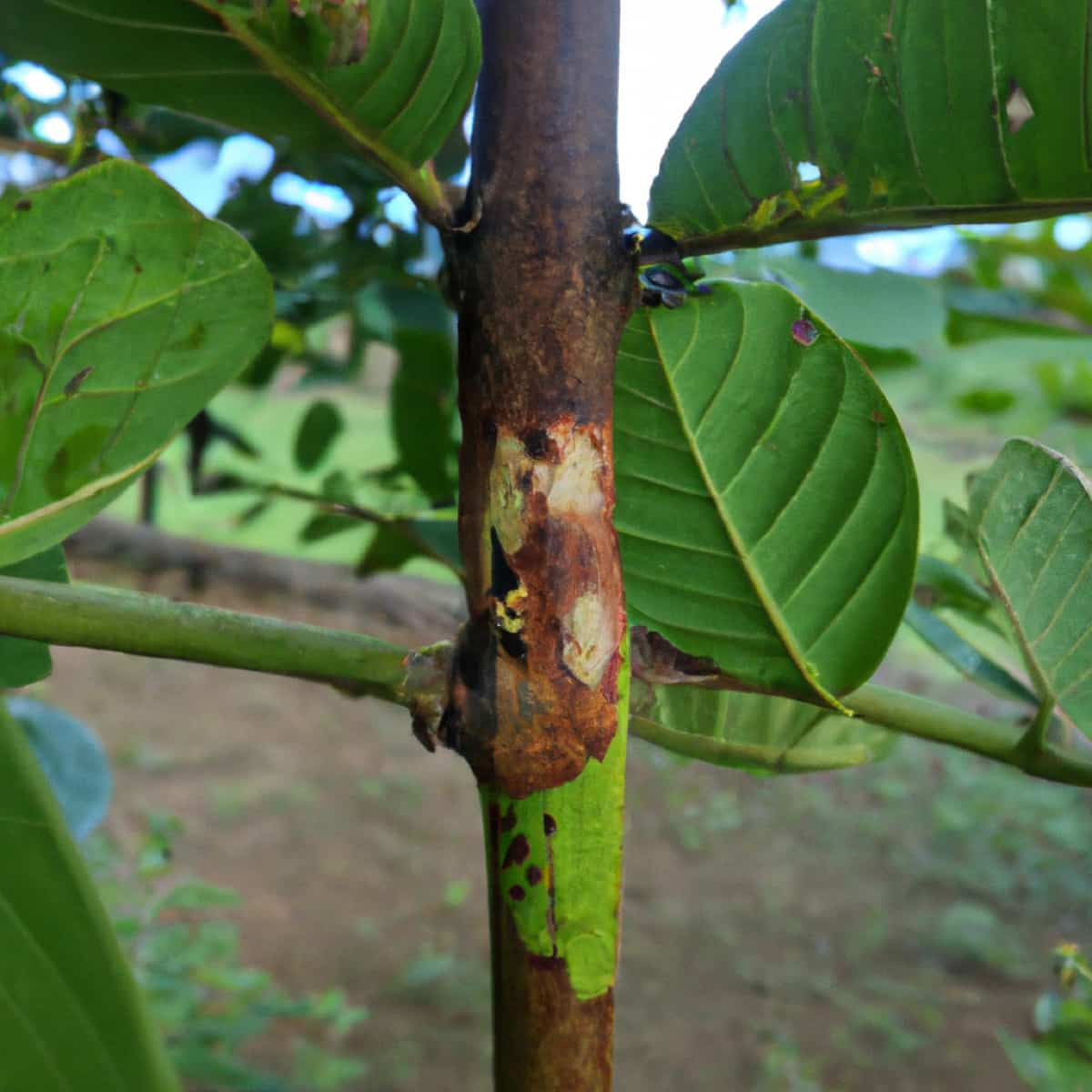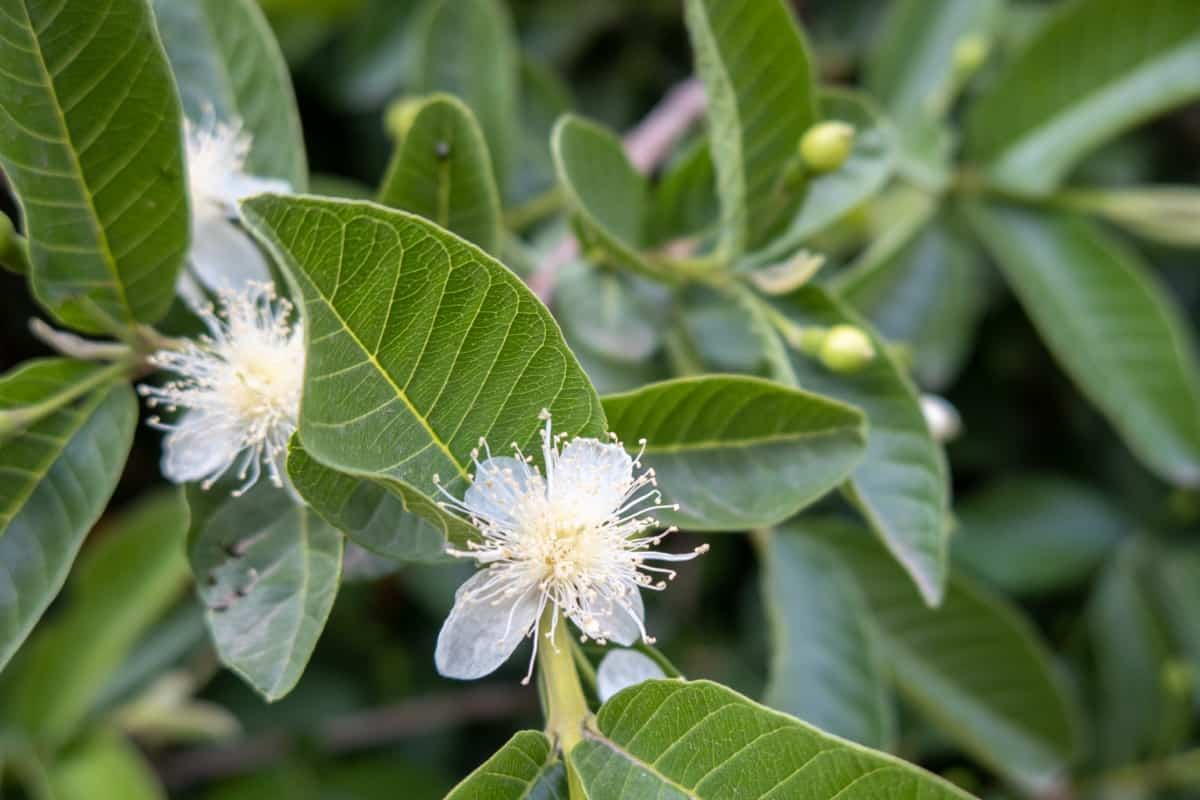Stem Canker Disease is a serious fungal disease that affects guava trees, causing stem canker and fruit rot: the pathogen Physalopara psidii and the imperfect stage Diplodia netalensis cause it. The disease can cause significant damage to the guava crop, resulting in reduced yields and economic losses for growers.

Stem Canker Disease Management in Guava
Causal Organism of Stem Canker Disease
The causal organism of Stem Canker Disease is a fungus called Physalopara psidii. It is a plant pathogen that infects the main branches and stems of various host plants, causing cracking lesions that can lead to wilt and death of the plant tissue. The fungus survives beneath the bark of infected plants and becomes active during favorable conditions, producing spores that can spread the disease to healthy plants.
Disease Cycle of Stem Canker Disease
- Overwintering: The pathogen survives the winter months beneath the bark of infected plants or in plant debris on the ground.
- Spring: With the onset of favorable conditions in the spring, the pathogen becomes active and begins to produce spores.
- Spore production: The pathogen produces spores called conidia, which are spread by wind or water to healthy plants.
- Infection: The pathogen’s spores infect the plant through wounds or natural openings in the bark and begin to grow and spread within the plant tissues.
- Lesion formation: The pathogen causes small, dark brown lesions on the branches and stem of the infected plant.
- Cracking: The lesions on the stem and branches can crack, causing further damage to the plant tissue.
- Wilting: As the pathogen kills the stem tissues, the affected branches will wilt and eventually die.
- Fungal perithecia: Small brown to black structures called perithecia may develop on the infected stem. These are the reproductive structures of the fungus and are visible to the naked eye.
- Spore dispersal: The perithecia produce spores called ascospores, which are released and can spread the disease to other healthy plants.
- Secondary infection: The ascospores can infect healthy plants, starting the cycle again.
Causes/Conditions Favorable for Stem Canker Disease Spread in the Field.
The rainy season favors the spread of stem canker disease, as the high moisture levels create a conducive environment for fungal growth and infection.
Symptoms of Stem Canker Disease
- Lesions: The first symptom of a stem canker disease is the appearance of small, dark brown lesions on the branches and stem of the affected plant.
- Cracking: The lesions on the stem and branches can crack, causing further damage to the plant tissue.
- Wilting: As the pathogen kills the stem tissues, the affected branches will wilt and eventually die.
- Fungal perithecia: Small brown to black structures called perithecia may develop on the infected stem. These are the reproductive structures of the fungus and are visible to the naked eye.
- Bark discoloration: The bark on the affected branches may become discolored, turning from brown to gray or black.
- Reduced growth: Infected plants with small leaves and branches may exhibit reduced growth and vigor.
- Dieback: Severe cases of stem canker disease can cause dieback, where entire branches or plant dies.
In case you missed it: Fruit Canker Disease Management in Guava: Symptoms, Treatment, Cultural, Chemical, and Preventive Measures

Stem Canker Disease Management in Guava by Cultural method
- Pruning and training: Regular pruning and training of guava plants can help to improve air circulation and sunlight penetration, reducing the likelihood of infection by the pathogen.
- Plant spacing: Proper plant spacing is important in managing Stem Canker Disease in Guava. Overcrowding can create a favorable condition for the spread of the disease. Adequate spacing between plants can increase air circulation and reduce humidity levels, making it less conducive for fungal growth and infection.
- Pest control: Controlling pests that may cause wounds or damage to the plant tissue can also help manage Stem Canker Disease in Guava. This is because wounds provide entry points for the pathogen to infect the plant.
Stem Canker Disease Management in Guava by Biological method
- Composting: Composting is an effective way to improve soil health and promote the growth of healthy guava plants. Composting can help to suppress the growth of fungal pathogens by increasing the population of beneficial microorganisms in the soil.
- Use of Trichoderma viride: Trichoderma viride is a beneficial fungus that can control Stem Canker Disease in Guava. It is an effective biological control agent competing with the pathogen for nutrients and space. Trichoderma viride can be applied to the soil or the guava plants as a biocontrol agent.
Stem Canker Disease Management in Guava by Organic/Natural method
- Use of neem oil: Neem oil is a natural pesticide that can control the spread of fungal pathogens like the one that causes Stem Canker Disease in Guava. It has antifungal properties and can be applied to guava plants to prevent fungal infection.
- Bagging of fruits: Bagging fruits using foam nets is an effective way to prevent fruit injury and reduce the spread of fungal pathogens like the one that causes Stem Canker Disease in Guava. Bagging the fruits helps to create a physical barrier between the fruit and the environment, preventing injury and infection.
Stem Canker Disease Management in Guava by Chemical method
Fungicides: Fungicides such as copper oxychloride can be sprayed on guava plants to control the spread of Stem Canker Disease. Spraying should be done after pruning to reduce the incidence of the disease. Copper oxychloride effectively controls fungal pathogens and is recommended at a concentration of 0.2%.
Bordeaux paste: Bordeaux paste is a combination of copper sulphate, lime, and linseed oil that can be applied to the cut ends of branches to prevent the entry of the pathogen. Bordeaux paste effectively prevents infection by fungal pathogens and can be applied to guava plants to prevent the spread of Stem Canker Disease.
Chaubatia paste: Chaubatia paste is another type that can be applied to the cut ends of branches to prevent infection by the pathogen. It comprises copper carbonate, red lead, and linseed oil, effectively preventing fungal infection.
Systemic fungicides: Systemic fungicides can be applied to guava plants to control the spread of Stem Canker Disease. The plant absorbs these fungicides and provides long-term protection against fungal pathogens.
Preventive Measures for Control of Stem Canker Disease
- Proper irrigation management is important in preventing the development of Stem Canker Disease. Avoid overwatering as it creates favorable conditions for fungal growth and infection. In addition, summer irrigation can help reduce the risk of infection by promoting the growth of healthy guava plants.
- Nutritional management is also important in preventing the development of Stem Canker Disease. Ensure that the guava plants receive adequate nutrients to promote healthy growth and prevent stress, which can make the plants more susceptible to infection.
- Pruning and sanitation practices can help to reduce the spread of Stem Canker Disease. Prune infected branches and stems and destroy them to prevent the spread of the disease. Keep the orchard clean by removing fallen leaves and debris that may harbor the pathogen.
In case you missed it: Fusarium Wilt Disease Management in Guava: Symptoms, Treatment, Cultural, Chemical, Biological, and Prevention

Conclusion
Stem Canker Disease is a significant threat to guava cultivation but can be effectively managed through cultural, chemical, and natural methods. Proper irrigation and nutritional management, pruning and sanitation, and bagging of fruits are some preventive measures that can be taken to control the spread of the disease. In addition, the use of fungicides can also be effective in preventing fungal infection. By implementing these measures, growers can ensure healthy growth and high yields of their guava crop.
- Deworming Schedule for Dogs/Puppies: A Beginners Guide
- How to Prevent and Control Parasites in Goats
- Beneficial Insects in Pest Management
- Natural Solutions for Pest Control in Flower Gardens
- Types of Fungicides Used in Agriculture
- Common Issues in the Fruit Development Stage of Pomegranate Farming
- Fruit Development Issues in Papaya: Easy Solutions and Treatment
- Soil-Borne Diseases and How to Protect Your Plants
- Practices to Prevent Disease Spread in the Garden